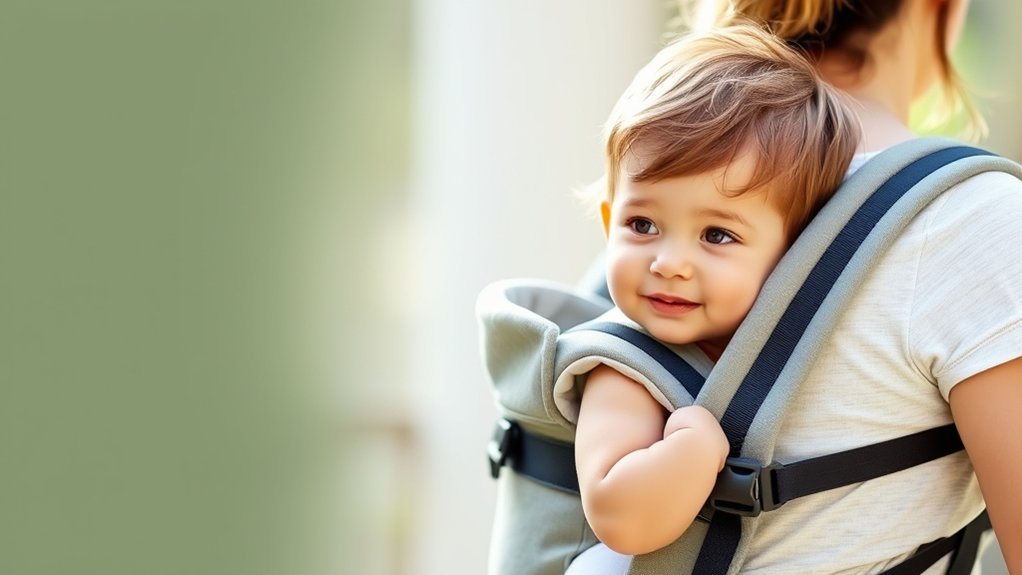Back carrying can feel like a delicate dance, weaving comfort and closeness into your daily routine. Yet, many misconceptions surround it, leaving caregivers unsure about its safety and benefits. Understanding the facts behind back carrying is essential for both you and your child. So, what do you really need to know to guarantee a positive experience? Let’s explore the truths that can help you navigate this nurturing practice with confidence.
Common Myths About Back Carrying
When it comes to back carrying, many parents often find themselves swayed by common myths that can cause unnecessary worry. You might hear back carry misconceptions suggesting that it’s unsafe or that it hinders your child’s development.
These back carry stereotypes can make you feel anxious about trying this liberating method. In reality, back carrying can offer both comfort and closeness, allowing you to bond with your child while keeping your hands free.
It’s essential to trust your instincts and recognize that when done correctly, back carrying can be a wonderful experience for both you and your little one.
Don’t let fear hold you back; embrace the freedom of back carrying and enjoy the journey together!
The Importance of Proper Technique
While it’s tempting to jump right into back carrying, mastering proper technique is vital for both your comfort and your child’s safety.
Achieving proper alignment guarantees that your body can support your little one without strain. When you focus on correct baby positioning, you not only promote your child’s comfort but also provide them with a sense of security.
The right technique allows you to move freely, embracing the liberation that back carrying offers. Remember, a well-adjusted carry minimizes the risk of discomfort for both you and your child.
Take the time to practice and refine your skills—it’s worth it for those joyful, hands-free moments. So, invest in learning, and enjoy the journey of back carrying together!
Safety Considerations for Back Carries
Before you start back carrying, it’s essential to reflect on several safety factors that can affect both you and your child.
Conducting a thorough risk assessment will help guarantee a safe experience. Here are some key safety guidelines to take into account:
- Choose a supportive carrier that distributes weight evenly.
- Always check the carrier for wear and tear before each use.
- Maintain proper posture to avoid strain on your back.
- Ensure your child is securely strapped in and comfortable.
- Be mindful of your surroundings to prevent trips or falls.
Benefits of Back Carrying for Caregivers and Babies
Back carrying not only enhances your mobility but also provides a host of benefits for both you and your baby.
When you carry your little one on your back, you boost their bonding benefits, fostering a deep emotional connection. This closeness allows your baby to feel secure while you go about your day, enhancing their comfort levels.
For you, back carrying frees up your hands, letting you tackle daily tasks with ease. It can make outings more enjoyable, as your baby can observe the world from a safe vantage point while staying cozy against you.
Embracing back carries empowers you as a caregiver, allowing you to move freely while nurturing a strong bond with your child.
Tips for Getting Started With Back Carries
Getting started with back carries can feel challenging, but with a little practice and guidance, you’ll find it to be a rewarding experience.
Here are some tips to help you master back carry techniques and guarantee proper baby positioning:
- Choose a comfortable carrier that suits you and your baby’s needs.
- Practice in front of a mirror to refine your technique and boost confidence.
- Start with your baby in a seated position, ensuring their legs are supported.
- Use a spotter for safety, especially when you’re new to back carries.
- Adjust the carrier for a snug fit, keeping your baby close and secure.
With patience and perseverance, you’ll embrace the freedom and connection that back carrying brings.
Frequently Asked Questions
Can I Back Carry a Toddler in a Regular Baby Carrier?
Yes, you can back carry a toddler in a regular baby carrier, but make certain it’s safe and supports their comfort. Check the carrier’s guidelines to keep your little one secure and happy while you move freely.
What Age Is Appropriate for Starting Back Carries?
You can start back carrying your toddler around 6-12 months, depending on their head and neck control. Always follow age guidelines, ensuring they’re ready for the comfort and safety of back carries.
How Do I Choose the Right Carrier for Back Carrying?
When choosing a carrier for back carrying, consider the carrier types that suit your needs. Look for safety features like secure straps and ergonomic support to guarantee both you and your child are comfortable and safe.
Can Back Carries Be Used for Special Needs Children?
Yes, back carries can absolutely benefit special needs children. When selecting adaptive carriers, prioritize safety considerations to guarantee comfort and stability. You’ll find that the right carrier promotes bonding while enhancing mobility for both of you.
Are There Cultural Differences in Back Carrying Techniques?
Absolutely, cultural practices shape back carrying techniques, intertwining traditional methods with community values. Each style reflects a rich tapestry of history and identity, offering you a glimpse into diverse experiences that celebrate the bond between caregiver and child.
Conclusion
In the world of back carrying, knowledge is power. By debunking myths and mastering proper techniques, you can create a secure and nurturing environment for your baby while keeping your hands free for daily tasks. Remember, “a happy baby makes a happy caregiver.” Embrace the benefits of back carrying, and trust that this practice can strengthen your bond and enhance your daily life together. So, get started, and enjoy the journey!
